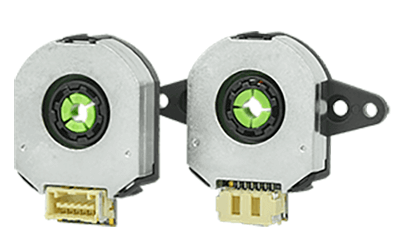What Is an Absolute Encoder?

An Absolute Encoder is an encoder that outputs an absolute angle from the origin.
An encoder is a device that converts a change in position into an electrical signal and outputs it. Since a specific signal is sent according to the angle, the current angle can be checked without previous angle information.
It is used when you want to detect the angle immediately after starting the power supply or when you want to ensure the reliability of angle detection. Most absolute encoders use an optical encoder.
Uses of Absolute Encoders
The use of absolute encoders is rapidly expanding in the field of robotics due to their high reliability in angle detection. Specific applications include the following
- Articulated arm robots
- Remote surgical robots
- Machine tools for precision parts
- Industrial robots for automotive production lines
- Industrial product delivery equipment
- Hand and foot joint movements for cooperative robots
As tele-operated robots are expected to evolve rapidly along with increasingly sophisticated control systems in the future, the need for absolute encoders is likely to increase.
Principle of Absolute Encoders
An absolute encoder consists of a disk with a small groove on its rotating shaft, which is read by an optical sensor. The structure is similar to a CD fixed to the shaft. This structure allows the encoder to accurately read the position of the disk and output the current angle even at the moment the power is turned on.
However, because the mechanism for reading the angle is complex, it is more expensive than an encoder for relative angle detection. There are also digital and analog signal transmission methods.
Digital Method
While it is resistant to noise, it requires more signal lines. Using transmission communication such as serial communication can reduce the number of signal lines. However, communication delays may occur and dedicated transmitters/receivers are required for both transmitting and receiving devices.
Analog Method
Two signal lines are used, and no delay occurs, but it is vulnerable to noise during transmission.
Based on the above characteristics, it is necessary to select the transmission method that best suits the purpose.
Other Information on Absolute Encoders
1. Gray Code Use of Absolute Encoders
Absolute encoders are available in magnetic and optical types, with the optical type being the most common. In the optical type, Gray code is often used as an encoding technique for rotating disks.
Gray code is a type of numeric encoding called alternating binary code. Gray codes are used to ensure that adjacent bits change by only one bit. When only one-bit changes, it is possible to prevent misreading of the signal.
To convert a normal binary number to a gray code, the binary value is shifted one character to the right, and an exclusive OR is obtained with the original binary value. For example, the binary representation of 6 in decimal is 0110. Shifting it one bit to the right yields 0011, and the exclusive OR of 0110 and 0011 is 0101. This is the gray code for 6 in decimal.
2. Battery-Less Absolute Encoder
Battery-less absolute encoders are available for servo motors. The absolute encoder detects absolute position with a small groove and saves the position information with a battery, eliminating the need for homing when resuming operation after the power is turned off. However, because they are battery-powered, maintenance is required due to battery life.
To compensate for this drawback, battery-less absolute encoders are now available from various manufacturers. The principle of battery-less encoders varies from company to company, but one example is the use of nonvolatile memory. When the motor rotates, the magnets attached to the shaft rotate together and generate their power. The generated power is used to write position information to the nonvolatile memory, thereby achieving battery-less operation.